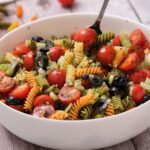While yeast is not intentionally added to commercial dried or fresh pasta, natural airborne yeast spores are nearly impossible to remove fully from flour and other ingredients. If left for long enough, these spores can hydrate and begin to multiply, introducing yeast into pasta dough. However, properly cooking pasta at boiling temperatures kills any potential yeast, rendering it incapable of fermentation. There is very low risk of yeast negatively impacting the quality, taste or shelf life of properly made and cooked pasta. Some yeast growth may be more likely with homemade pasta that sits for a long time before cooking, but heat treatment effectively neutralizes yeast present in both commercial and homemade pasta.
Commercial Pasta
While yeast is not an intentionally added ingredient in commercial dried or fresh pasta, small amounts of naturally occurring yeast may be present to some degree.
Mass produced pasta starts with high quality durum wheat semolina flour as the primary ingredient. However, this flour is exposed to the air during milling, storage and transportation. Airborne yeast spores can land on flour particles, becoming trapped within the flour.
If left for long enough, these dormant yeast spores can hydrate once the flour is combined with water to form pasta dough. Given adequate moisture and food sources like carbohydrates in the flour, the activated yeast can then begin to multiply and ferment, causing dough to rise.
However, several factors work together to limit yeast growth in commercial pasta production. The mixing and forming stages of pasta manufacturing are rapid, providing little time for activation and multiplication of natural yeast.
The coarse semolina flour used in pasta also contains less malted grains that yeast feeds on compared to finer all-purpose flour. Added salt in commercial pasta dough recipes can further inhibit yeast activity.
So while trace amounts of natural yeasts may be present in commercial pasta ingredients, the manufacturing process is designed to minimize yeast growth before the pasta is dried, cooked or frozen for sale. Any existing yeast would likely not impact taste or quality significantly.
Natural Yeasts
While commercial pasta production limits yeast growth, some natural yeast may be present due to the near-ubiquity of airborne yeast spores. Yeast spores are diminutive reproductive units that can remain dormant for long periods.
Yeast spores are widespread in the environment, floating through the air and landing on exposed surfaces. They can easily contaminate wheat flour during milling, packaging and storage. Even “fresh” flour may contain some dormant yeast spores.
If left for an extended time, these dormant yeast spores can activate once flour is combined with water or other wet ingredients to form pasta dough. The presence of moisture and carbohydrates in flour awakens the spores and initiates yeast reproduction.
Given enough time and suitable conditions, natural yeasts in flour can multiply rapidly and produce carbon dioxide gas as a byproduct of fermentation. This can cause dough or batter to rise noticeably.
The risk of natural yeast activation and growth is higher with homemade pasta that uses basic all-purpose flour and is allowed to rest for long periods before cooking. The finer flour contains more nutrients to support yeast, and more time provides an opportunity for yeast multiplication.
While a slight rise in homemade pasta dough is not necessarily harmful, it can impact the taste, texture and noodles’ ability to hold sauce properly. Excessive yeast growth should be avoided when making pasta by combining ingredients quickly and cooking the dough promptly.
Homemade Pasta
Because homemade pasta often involves mixing basic all-purpose flour that has been sitting for an unknown length of time, there is a higher chance of natural yeast activation compared to commercial pasta production.
When making pasta dough by hand, airborne yeast spores already present within the flour can become hydrated once liquid ingredients like eggs and water are added. The moisture awakens any dormant yeast, providing an opportunity for growth and fermentation.
If allowed to sit for 30 minutes or more after combining flour and liquids, the yeast can begin to multiply rapidly within the pasta dough. As yeast cells reproduce, they produce carbon dioxide gas that becomes trapped in the elastic gluten network of the dough.
The buildup of carbon dioxide causes the dough to rise noticeably in volume as the yeast ferments carbohydrates in the flour. The longer the dough sits at room temperature, the more pronounced the rise will be.
A slightly risen pasta dough is not necessarily harmful but can impact flavor and texture. The extra gas bubbles can alter the way the dough sheeting and formation, producing noodles that are puffy, uneven, and trap more air pockets. This affects how sauce is absorbed later.
To limit yeast growth when making homemade pasta dough, combine ingredients quickly and promptly begin sheeting, rolling or extruding the dough into shapes for cooking. The faster the dough is formed after mixing, the less likely it is to rise from natural yeast activation.
Killing Yeast
Here is a 248 word section on killing yeast in pasta:
While natural yeast may be present in commercial or homemade pasta dough, properly cooking the pasta at boiling temperatures will effectively kill any active yeast cells.
When pasta dough containing yeast is boiled in water, the high temperatures denature the yeast proteins andRNA structures. This causes the yeast cells to become non-functional and incapable of further reproduction or fermentation. Any rise in the dough prior to cooking will be undone.
The U.S. Department of Agriculture recommends heating most yeast-containing foods to an internal temperature of at least 160 degrees Fahrenheit in order to kill harmful bacteria and deactivate yeast. Boiling water for pasta reaches temperatures of 210 to 212 degrees, well above what is needed.
Even homemade pasta dough that has risen noticeably due to active yeast will immediately flatten out once plunged into boiling water. The high temperatures rupture the yeast cells and carbon dioxide bubbles within the dough, releasing the trapped gas and returning the pasta to its normal volume.
After cooking, the pasta will contain no living yeast and thus poses no risk of future rising, fermentation or change in flavor. Properly cooked pasta, whether commercial or homemade, will be stable at room temperature and safe to eat.
The key is to cook pasta for the recommended amount of time in boiling water. Undercooking could potentially leave some active yeast inside. But as long as the pasta is done, any yeast present in the original dough will have been neutralized by the cooking process.
Storing Pasta
When storing leftover cooked or uncooked pasta properly, there is very little risk of yeast growth affecting quality or flavor.
Uncooked dried pasta has a shelf life of at least 1 year when stored in a cool, dry place according to manufacturers. Any existing yeast present is inactive without the presence of moisture.
Cooked pasta stored in its original packaging or an airtight container in the refrigerator should remain fresh for 5 to 7 days. The cold temperatures impede yeast growth by slowing microbial activity.
As long as cooked pasta is consumed within about a week and is not left at room temperature for extended periods, there is little chance of yeast developing to a degree that impacted the pasta. If any mold appears or the pasta takes on an unpleasant odor, it should be discarded.
In general, properly stored pasta faces minimal risk from yeast contamination. Following manufacturer storage and expiration guidelines helps ensure the pasta will maintain freshness and flavor.
While trace amounts of natural yeast are impossible to remove fully from flour and other ingredients, properly cooked pasta faces very little risk from yeast negatively impacting flavor, texture or shelf life. Cooking pasta at boiling temperatures effectively kills any potentially active yeast, leaving inert cells that pose no threat. Strict adherence to manufacturer storage guidelines also limits yeast growth in both cooked and uncooked pasta.
FAQs
1. Does fresh pasta have yeast?
While fresh pasta is less likely to contain significant yeast due to its short manufacturing time, natural airborne yeast spores can contaminate ingredients and flour. However, cooked fresh pasta is just as safe from yeast as dried pasta.
2. Is homemade pasta dough supposed to rise?
Some rise in homemade pasta dough is normal if it sits for long periods, as natural yeasts activate and multiply. However, yeast growth should be limited by promptly forming and cooking the dough.
3. What temperature kills yeast in pasta dough?
Cooking pasta to an internal temperature of at least 160°F is recommended to kill yeast. Boiling water for pasta exceeds this at 210-212°F, ensuring all yeast cells are deactivated.
4. How can you tell if pasta has gone bad?
Signs of spoiled pasta include mold growth, an unpleasant odor, or discoloration. If in doubt, discard pasta after the manufacturer’s recommended shelf life or use by date.




